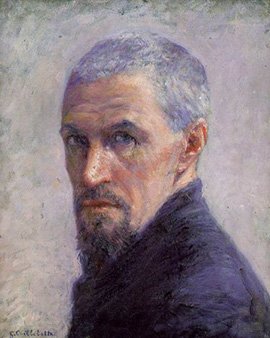Gustave Caillebotte was the eldest of three joint sons of Martial Caillebotte and his third wife Céleste Daufresne. The family belonged to the Parisian upper class and was very wealthy. Martial Caillebotte was the heir to a textile and laundry business that supplied the French military. He was also a judge at the commercial court. Because of their wealth, they could afford, in addition to their city palace in Paris, an extensive country estate in a small town outside Paris. From the age of 12 Gustave Caillebotte spent many summers there. Probably inspired by the surroundings, he began drawing around this time. Despite his early interest in art, he received a more classical education, studied law and was granted an official license to practice as a lawyer. Shortly after his graduation, the Franco-German war broke out and Caillebotte was drafted. After nine months he was discharged from the service and returned to Paris.
Caillebotte now decided to take painting seriously. He learned the basics in the studio of Leon Bonnat in order to prepare for the entrance examination at the École des Beaux-Arts. Although he was eventually accepted at the Academy, he hardly attended any courses. Instead, he met and became friends with some artists who were not connected with the Academy. Among them were Pierre Auguste Renoir, Edgar Degas, Claude Monet or Giuseppe de Nittis. He was present at the first exhibition of the Impressionists, but exhibited his works there only years later. In the same year his father died, so Caillebotte inherited a considerable fortune at the age of 25. He became one of the biggest supporters of the Impressionists and acquired many works by Monet, Renoir, Pissarro, Cézanne and others. For Monet, he is said to have even paid the rent for his studio.
Caillebotte continued to do the Impressionists a great service after his death. In his will, he had it stated that his large art collection would go to the French government after his death. At his request, these works were to be exhibited in the Luxembourg Palace and later in the Louvre. Caillebotte apparently already suspected during his lifetime that the work of the Impressionists would otherwise be forgotten in the country's most remote museums. The dispute over this agreement continued even after his death and was finally pushed through a few years later by his representatives Pierre-Auguste Renoir and his brother Martial. Although Gustave Caillebotte was a talented artist himself, he did not receive recognition for his work until long after his death. This was mainly because he never felt the financial pressure to sell his paintings due to his wealth. As a result, much of his work remained in the family's possession and hidden from public view for a long time. The special feature of his work was the combination of impressionism and realism.
×





.jpg)
.jpg)
.jpg)
.jpg)
.jpg)
.jpg)
.jpg)
.jpg)
.jpg)
.jpg)
_-_(MeisterDrucke-686008).jpg)
_-_(MeisterDrucke-686008).jpg)
.jpg)
.jpg)
.jpg)
.jpg)
.jpg)
.jpg)
.jpg)
.jpg)
.jpg)
.jpg)
.jpg)
.jpg)
.jpg)
.jpg)
.jpg)
.jpg)
.jpg)
.jpg)
.jpg)
.jpg)
.jpg)
.jpg)
.jpg)
.jpg)
.jpg)
.jpg)
.jpg)
.jpg)
.jpg)
.jpg)
.jpg)
.jpg)
.jpg)
.jpg)
 - (MeisterDrucke-109374).jpg)
 - (MeisterDrucke-109374).jpg)
.jpg)
.jpg)
.jpg)
.jpg)
.jpg)
.jpg)
.jpg)
.jpg)
.jpg)
.jpg)
.jpg)
.jpg)
.jpg)
.jpg)
.jpg)
.jpg)
_-_oil_on_canvas_-_(MeisterDrucke-1021896).jpg)
_-_oil_on_canvas_-_(MeisterDrucke-1021896).jpg)
_dit_Toits_sous_la_neige_-_(MeisterDrucke-685123).jpg)
_dit_Toits_sous_la_neige_-_(MeisterDrucke-685123).jpg)
.jpg)
.jpg)
.jpg)
.jpg)
.jpg)
.jpg)
_-_(MeisterDrucke-687896).jpg)
_-_(MeisterDrucke-687896).jpg)
.jpg)
.jpg)
.jpg)
.jpg)
.jpg)
.jpg)
.jpg)
.jpg)
 - (MeisterDrucke-244573).jpg)
 - (MeisterDrucke-244573).jpg)
.jpg)
.jpg)
.jpg)
.jpg)
.jpg)
.jpg)
.jpg)
.jpg)
.jpg)
.jpg)
.jpg)
.jpg)
.jpg)
.jpg)
.jpg)
.jpg)
_-_(MeisterDrucke-909474).jpg)
_-_(MeisterDrucke-909474).jpg)
.jpg)
.jpg)
.jpg)
.jpg)
.jpg)
.jpg)
.jpg)
.jpg)
.jpg)
.jpg)
.jpg)
.jpg)
.jpg)
.jpg)
.jpg)
.jpg)
.jpg)
.jpg)
.jpg)
.jpg)
.jpg)
.jpg)
.jpg)
.jpg)
.jpg)
.jpg)
.jpg)
.jpg)
.jpg)
.jpg)
.jpg)
.jpg)
.jpg)
.jpg)
.jpg)
.jpg)
.jpg)
.jpg)
.jpg)
.jpg)
.jpg)
.jpg)
_-_(MeisterDrucke-1466507).jpg)
_-_(MeisterDrucke-1466507).jpg)
.jpg)
.jpg)
.jpg)
.jpg)
.jpg)
.jpg)
.jpg)
.jpg)
.jpg)
.jpg)
.jpg)
.jpg)
.jpg)
.jpg)
_-_(MeisterDrucke-985381).jpg)
_-_(MeisterDrucke-985381).jpg)
.jpg)
.jpg)
_teacher_at_the_School_of_Oriental_Language_-_(MeisterDrucke-109387).jpg)
_teacher_at_the_School_of_Oriental_Language_-_(MeisterDrucke-109387).jpg)
.jpg)
.jpg)
.jpg)
.jpg)
.jpg)
.jpg)
.jpg)
.jpg)
.jpg)
.jpg)
.jpg)
.jpg)
.jpg)
.jpg)
.jpg)
.jpg)
.jpg)
.jpg)
.jpg)
.jpg)
.jpg)
.jpg)
.jpg)
.jpg)
.jpg)
.jpg)
.jpg)
.jpg)
.jpg)
.jpg)
_-_(MeisterDrucke-1023438).jpg)
_-_(MeisterDrucke-1023438).jpg)






